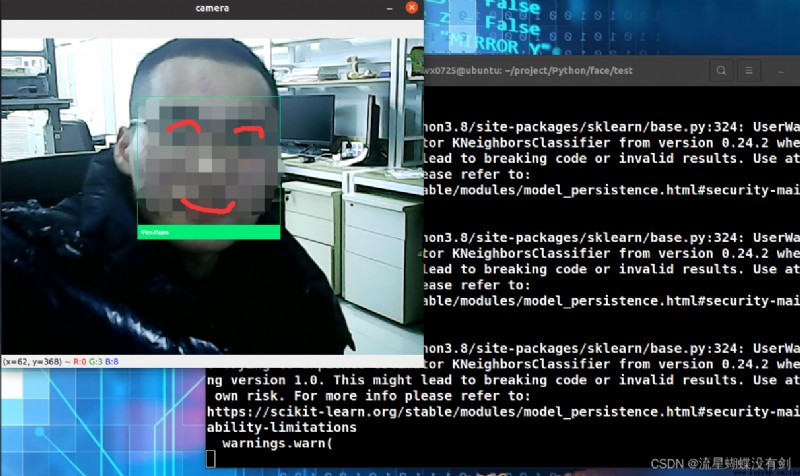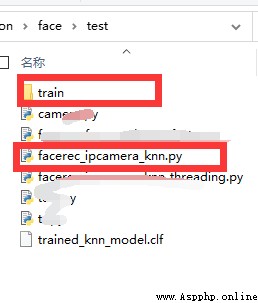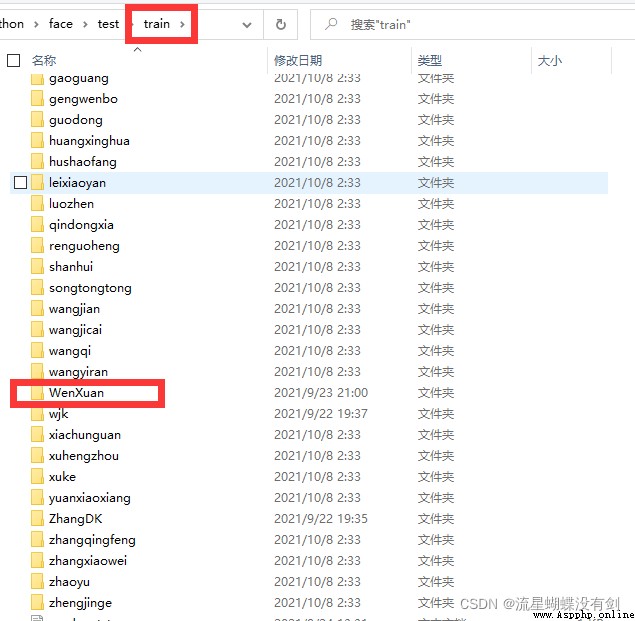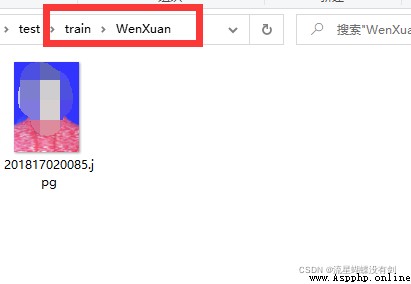
代碼和人臉庫在同一級
訓練庫中以人名命名文件夾
每個人可以多張圖片,這裡的名字無所謂
# 先:
sudo su root
apt-get install -y git
apt-get install -y cmake
apt-get install -y python3-pip
apt-get install libboost-all-dev
git clone https://github.com/davisking/dlib.git
cd dlib
mkdir build
cd build
cmake .. -DDLIB_USE_CUDA=0 -DUSE_AVX_INSTRUCTIONS=1
cmake --build .
cd ..
# 可能會報錯
# 第一種:
python3 setup.py install --yes USE_AVX_INSTRUCTIONS --no DLIB_USE_CUDA
# 第二種
python3 setup.py install --set USE_AVX_INSTRUCTIONS=1 --set DLIB_USE_CUDA=1
# 修改 ~/.pip/pip.conf (沒有就創建一個)
[global]
index-url = https://pypi.tuna.tsinghua.edu.cn/simple
pip3 install face_recognition
pip install scikit-build
sudo apt-get install build-essential
sudo apt-get install cmake git libgtk2.0-dev pkg-config libavcodec-dev libavformat-dev libswscale-dev
sudo apt-get install python-dev python-numpy libtbb2 libtbb-dev libjpeg-dev libpng-dev libtiff-dev libjasper-dev libdc1394-22-dev
# 上面有報錯的執行
sudo add-apt-repository "deb http://security.ubuntu.com/ubuntu xenial-security main"
sudo apt update
sudo apt install libjasper1 libjasper-dev
python3 -m pip install --upgrade pip
pip3 install opencv-python
pip3 install scikit-learn
# npm
sudo apt-get install npm
npm config set registry https://registry.npm.taobao.org
參考文章:
import cv2
import math
from sklearn import neighbors
import os
import os.path
import pickle
from numba import cuda
from PIL import Image, ImageDraw
import face_recognition
from face_recognition.face_recognition_cli import image_files_in_folder
import numpy as np
ALLOWED_EXTENSIONS = {
'png', 'jpg', 'jpeg', 'JPG'}
# cuda.select_device(1)
# @cuda.jit
# def gpu():
# pass
# 訓練(訓練的目錄, 訓練庫保存的位置, )
def train(train_dir, model_save_path=None, n_neighbors=None, knn_algo='ball_tree', verbose=False):
X = []
y = []
for class_dir in os.listdir(train_dir):
if not os.path.isdir(os.path.join(train_dir, class_dir)):
continue
print("開始訓練用戶:", class_dir, "...", end="")
images = []
for img_path in image_files_in_folder(os.path.join(train_dir, class_dir)):
image = face_recognition.load_image_file(img_path)
images.append(image)
S = face_recognition.batch_face_locations(images, number_of_times_to_upsample=1, batch_size=len(images))
for face_bounding_boxes in S:
if len(face_bounding_boxes) != 1:
if verbose:
print("圖片中人臉太多或者不存在人臉,不適合進行訓練")
else:
X.append(face_recognition.face_encodings(image, known_face_locations=face_bounding_boxes)[0])
y.append(class_dir)
print("訓練結束")
if n_neighbors is None:
n_neighbors = int(round(math.sqrt(len(X))))
if verbose:
print("Chose n_neighbors automatically:", n_neighbors)
knn_clf = neighbors.KNeighborsClassifier(n_neighbors=n_neighbors, algorithm=knn_algo, weights='distance')
knn_clf.fit(X, y)
if model_save_path is not None:
with open(model_save_path, 'wb') as f:
pickle.dump(knn_clf, f)
return knn_clf
def predict(X_frame, knn_clf=None, model_path=None, distance_threshold=0.5):
if knn_clf is None and model_path is None:
raise Exception("Must supply knn classifier either thourgh knn_clf or model_path")
if knn_clf is None:
with open(model_path, 'rb') as f:
knn_clf = pickle.load(f)
X_face_locations = face_recognition.face_locations(X_frame)
if len(X_face_locations) != 1:
return []
faces_encodings = face_recognition.face_encodings(X_frame, known_face_locations=X_face_locations)
closest_distances = knn_clf.kneighbors(faces_encodings, n_neighbors=1)
are_matches = [closest_distances[0][i][0] <= distance_threshold for i in range(len(X_face_locations))]
return [(pred, loc) if rec else ("", loc) for pred, loc, rec in
zip(knn_clf.predict(faces_encodings), X_face_locations, are_matches)]
""" X_face_locations = face_recognition.face_locations(X_frame) S = face_recognition.batch_face_locations([X_frame], number_of_times_to_upsample=1, batch_size=128) for face_bounding_boxes in S: print(face_bounding_boxes) if len(face_bounding_boxes) != 1: return [] faces_encodings = face_recognition.face_encodings(X_frame, known_face_locations=face_bounding_boxes) # 匹配人臉 closest_distances = knn_clf.kneighbors(faces_encodings, n_neighbors=1) are_matches = [closest_distances[0][i][0] <= distance_threshold for i in range(len(X_face_locations))] return [(pred, loc) if rec else ("", loc) for pred, loc, rec in zip(knn_clf.predict(faces_encodings), X_face_locations, are_matches)] return [] """
def show_prediction_labels_on_image(frame, predictions):
pil_image = Image.fromarray(frame)
draw = ImageDraw.Draw(pil_image)
for name, (top, right, bottom, left) in predictions:
# enlarge the predictions for the full sized image.
top *= 2
right *= 2
bottom *= 2
left *= 2
# Draw a box around the face using the Pillow module
if name == "":
rgbFace = (0, 0, 255)
else:
rgbFace = (118, 238, 0)
draw.rectangle(((left, top), (right, bottom)), outline=rgbFace)
name = name.encode("UTF-8")
text_width, text_height = draw.textsize(name)
draw.rectangle(((left, bottom - text_height - 10), (right, bottom)), fill=rgbFace, outline=rgbFace)
draw.text((left + 6, bottom - text_height - 5), name, fill=(255, 255, 255, 255))
del draw
opencvimage = np.array(pil_image)
return opencvimage
def set_gpus(gpu_index):
if type(gpu_index) == list:
gpu_index = ','.join(str(_) for _ in gpu_index)
if type(gpu_index) == int:
gpu_index = str(gpu_index)
os.environ["CUDA_DEVICE_ORDER"] = "PCI_BUS_ID"
os.environ["CUDA_VISIBLE_DEVICES"] = gpu_index
if __name__ == "__main__":
set_gpus(0)
train_flag = 1
# 1表示訓練、0表示不訓練【訓練一次之後建議改為0,提高效率,更圖片或者添加人臉後需要重新訓練】
if train_flag:
print("Training KNN classifier...")
classifier = train("./train", model_save_path="trained_knn_model.clf", n_neighbors=2)
print("Training complete!")
print('Setting cameras up...')
# 攝像頭讀取:https://blog.csdn.net/qq_44009311/article/details/121799698
cap = cv2.VideoCapture(0)
while 1 > 0:
ret, frame = cap.read()
if ret:
img = cv2.resize(frame, (0, 0), fx=0.5, fy=0.5)
predictions = predict(img, model_path="trained_knn_model.clf")
frame = show_prediction_labels_on_image(frame, predictions)
cv2.imshow('camera', frame)
if ord('q') == cv2.waitKey(10):
cap.release()
cv2.destroyAllWindows()
exit(0)